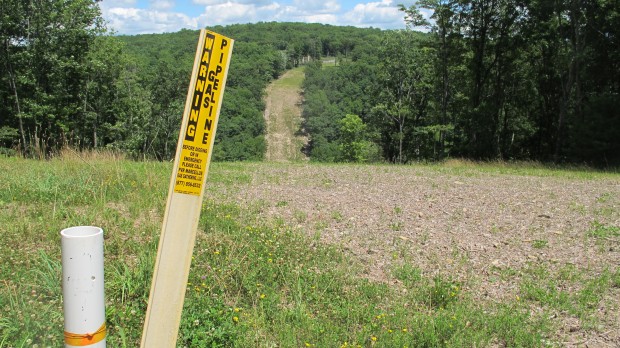As pipelines proliferate, Pennsylvania sees next phase of gas boom
-
Marie Cusick

A natural gas pipeline cuts through the woods in Lycoming County. More than $10 billion in pipeline projects have been announced for Pennsylvania.
The surge in drilling has meant trillions of cubic feet of natural gas are being pumped out of Pennsylvania every year. And now billions of dollars are flooding into the state for new pipeline projects to move that gas to market.
It’s the next phase of the fracking boom: energy companies are building their own sort of interstate highway system—a network of pipelines.
“A sense of urgency”
Matt Henderson, of Penn State’s Marcellus Center for Outreach and Research, says more than $10 billion in pipeline projects have already been announced for Pennsylvania.
“Production has outpaced anybody’s wildest expectations,” he says. “The operators were found in a position where, ‘We need to get this out.’ So there’s a sense of urgency.”
Industry representatives say undoubtedly not all of the proposed pipelines will get built. But there’s still a race to get gas to customers.
Houston-based Cabot Oil & Gas has been able to ship its gas out of northeastern Pennsylvania on three existing interstate pipelines. Company spokesman Bill DeRosiers says Cabot is partnering with other companies on new projects to ease bottlenecks in the system, like the $700 million Constitution pipeline. It was recently approved by federal regulators to carry Marcellus gas to New York and New England.
And there’s an even bigger one on the horizon.
“The Atlantic Sunrise is another pipeline project that will actually head south,” says DeRosiers.
The $3 billion line would cut through 10 central Pennsylvania counties. If it’s approved by regulators, it could be operational in two years. It would start near Cabot’s operations in Susquehanna County and go as far south as Alabama.
“It will actually bring gas along the eastern seaboard markets as far south for Cabot’s interests to Cove Point which is an exportation terminal, where Cabot’s looking forward to exporting to Japan,” says DeRosiers.
Fetching a higher price for its gas overseas would obviously be good news for Cabot. But this surge in gas infrastructure has also sparked a new round of fracking-related fears and concerns.

Protesters blocked entrances to the Federal Energy Regulatory Commission headquarters in Washington D.C. last summer. Twenty-four people were arrested.
Two dozen protesters were arrested last summer outside the Washington D.C. headquarters of the Federal Energy Regulatory Commission (FERC). The commission oversees interstate pipelines and export facilities—like the Cove Point terminal, located along the Chesapeake Bay. The protesters argue sending more gas abroad will mean more environmental harm from drilling back home.
Local opposition
It’s not hard to find passionate opposition to pipelines elsewhere, particularly in southeastern Pennsylvania, which has been largely untouched by the drilling boom so far.
Many people fear gas companies will use eminent domain to seize their property. New York landowners along the route of the Constitution pipeline recently received letters threatening exactly that.
Because siting interstate pipelines is a federal decision, it’s unlikely Pennsylvania’s State Supreme Court ruling on Act 13—which affirmed the right of local governments to zone gas development—will have much effect.
Attorney Jordan Yeager represented local governments in the case. He believes there’s still a chance the ruling could play a role.
“One of the components that FERC looks at is whether what’s being proposed is going to be consistent with and respect state and local laws and ordinances,” he says. “So with that, it’s not necessarily a trump card, but it’s part of what needs to be considered.”
After Philadelphia-based Sunoco Logistics said it wanted to retrofit an existing pipeline to carry natural gas liquids across the state, it met with community resistance. The company recently announced plans for second, $2.5 billion pipeline to run parallel to the first.
Mark Clatterbuck’s home in Lancaster County is along a proposed route for the Atlantic Sunrise pipeline. He’s doubtful federal regulators will listen to his concerns about safety and environmental degradation.
“I have essentially zero hope that FERC will take that seriously,” he says.
It’s true that FERC often approves pipelines, but the agency says it doesn’t track how often.
“A much bigger economic story”
But industry representatives argue the public’s fears are overblown. There are already about 2.6 million miles of gas pipelines in the United States.
Fatal accidents do happen, but they’re relatively rare. According to federal data, 362 people have died over the past 20 years– 25 of those were in Pennsylvania. Those figures include all kinds of pipelines: transmission, distribution, gathering, and hazardous liquid.
Still, environmental groups complain they get left out of the planning process. Katy Dunlap of Trout Unlimited says she feels like they missed the boat when the drilling boom began seven years ago.
“We have tried to have discussions with companies about getting involved in the planning upfront,” she says. “And what we’ve been told time and time again is that most of this planning has already been done.”
Anthony Cox works for UGI Energy Services– the company behind the proposed $1 billion PennEast pipeline which would carry gas from the northeastern Pennsylvania into New Jersey.
He understands many people may not like a new interstate transmission line in their backyard, but argues there are other economic benefits—like ensuring the flow of gas to cut down on price volatility.
“But it goes beyond that to talk about increased natural gas, which leads to increased competitiveness for local businesses which increases jobs and lowers taxes for everybody,” says Cox. “There’s a much bigger macroeconomic story to be told here.”
It’s a story that will continue to unfold as the shale gas boom enters another phase in Pennsylvania.
















